

sustainers for stringed musical instruments
SUSTAINIACÒ
SUSTAIN-MAN ELECTRO-ACOUSTIC SUSTAINERA sustainer is the only effect that operates directly on the strings of the instrument. All other effects change the signal that you hear.
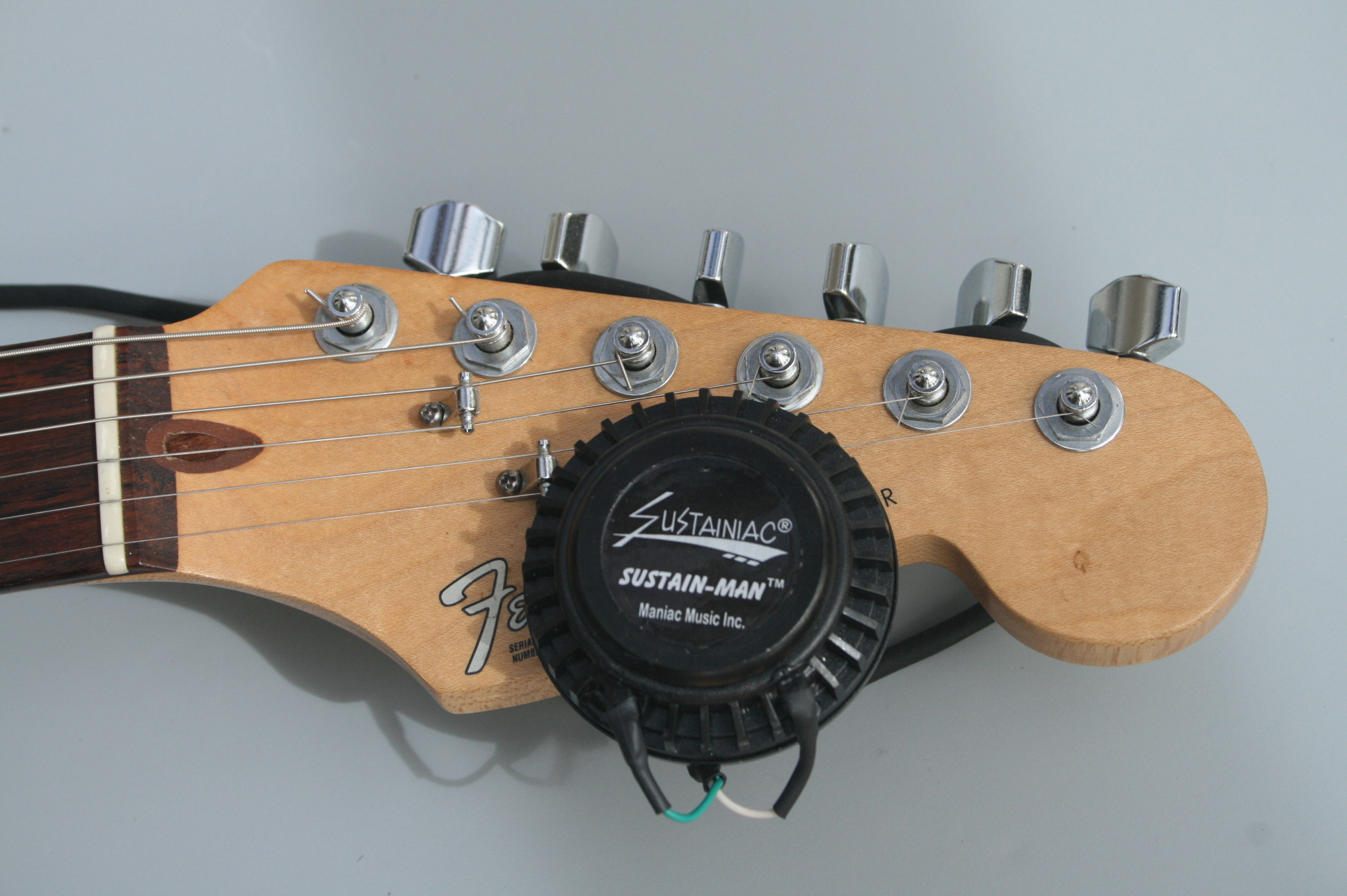
|
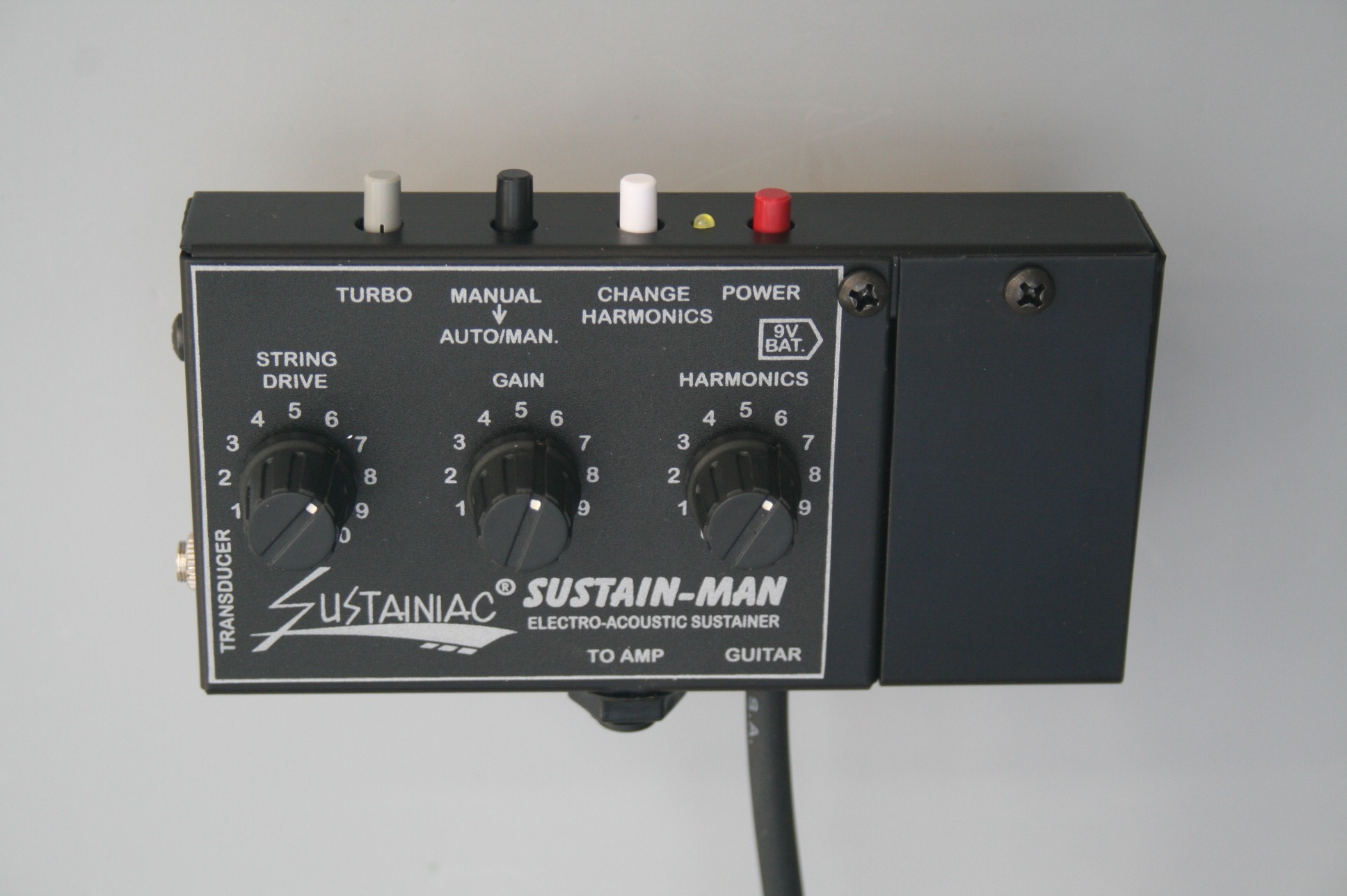 |
SUSTAIN-MAN SOUND SAMPLES:
Here is a link to a recent Sustain-Man demo (June 2020) from Casey Harshbarger and Bart Michaels, two of our shop technicians and most excellent guitar players (also super-guys). Sustainiac Sustain-Man Bart and Casey "SUSTAINED FLIGHT"
Here is a Youtube link to a recent Sustain-Man demo (July 2020) from Casey Harshbarger who works (and plays) in our shop. Sustainiac Sustain-Man-Casey
Here is a link to a recent Sustain-Man demo (Jan. 2018) from Russ Wilson in Pennsylvania.
Sustainiac Sustain-Man Russ
The SUSTAIN-MAN electroacoustic-type sustainer replaces the Model B and Model C sustainers. The Model B was introduced in 1987 and
was discontinued in the year 2000. The Model C was introduced in 2003 and discontinued in 2014.
The retail price for the SUSTAIN-MAN is $229.00 (US dollars).
Both the Sustainiac Model B and Model C were unique, groundbreaking sustain devices. The Sustain-Man is also unique and even more groundbreaking
than the Models B&C. The SUSTAIN-MAN eliminates the cord hanging down from the headstock to the floor problem. A new transducer design allows
strong, fast sustain on a small fraction of the power previously required. It is powered by a single 9-volt battery.
The control box attaches to the front of the guitar body by an included aluminum bracket. The bracket is covered with hook-and-loop fastening tape, as is the bottom of the SUSTAINIAMP control box. The mounting bracket is attached to the guitar body by the strap button. The SUSTAIN-MAN is powered by a single 9-volt battery. See mounting details in the following picture:
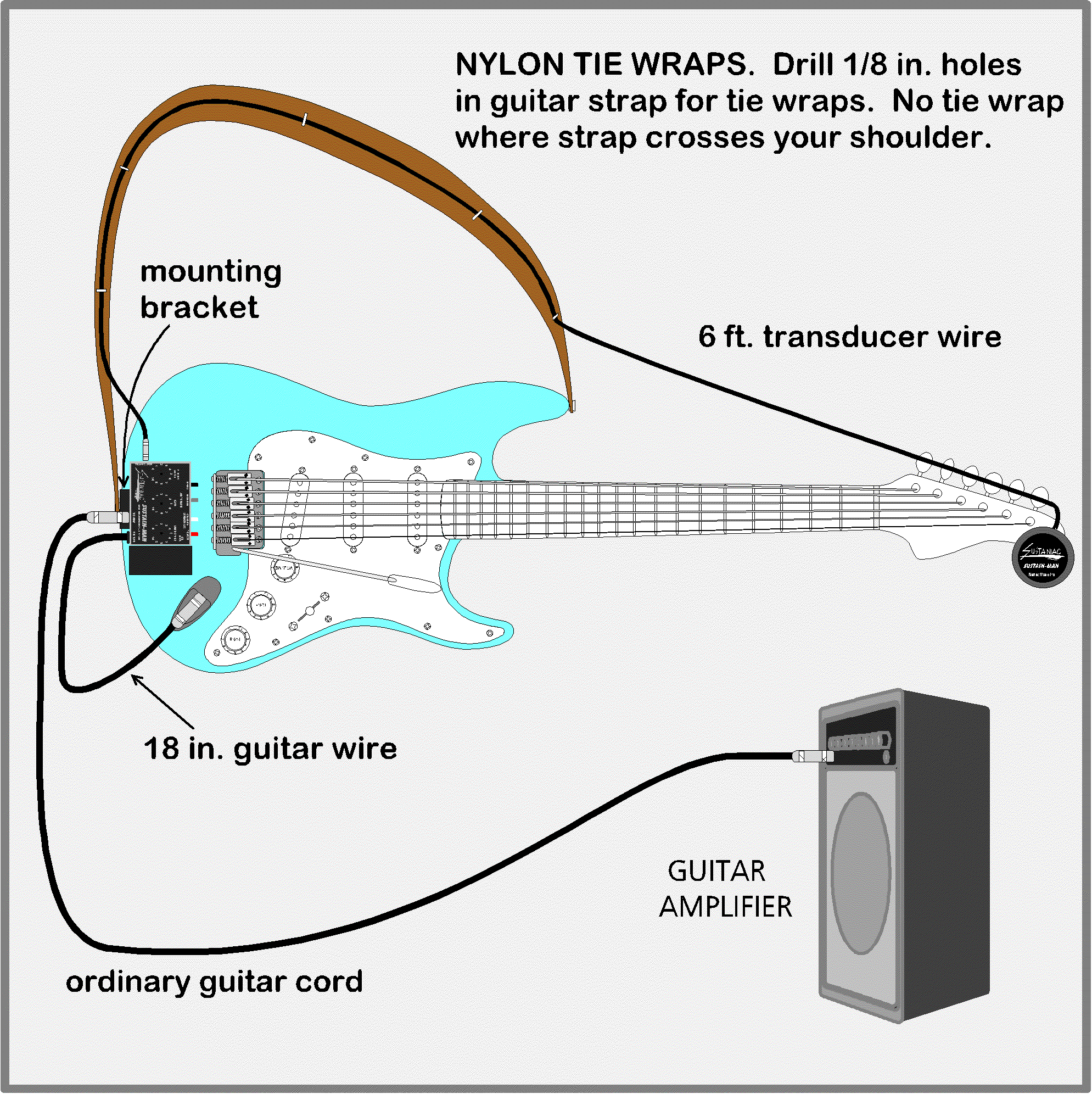
TOPIC LIST
Overview of the SUSTAIN-MAN electro-acoustic sustainer
Basic differences between the SUSTAIN-MAN and Models B&C sustainers
No Installation Required
Performing with the SUSTAIN-MAN
Comparison of SUSTAIN-MAN with Stealth PRO and other electromagnetic sustainers
How intense is it?
Features and Controls
Harmonic sustain: Dual Mode Harmonic Select control
Knob Functions
Transducer mounting details
Guitars with piezo and other bridge types
Pricing
Ordering information
Warranty
Specifications:
How the SUSTAINIAC SUSTAIN-MAN electro-acoustic sustainer works
SUSTAIN-MAN Owner's manual (PDF file)
Overview of the SUSTAINIAC SUSTAIN-MAN sustainer
The Sustainiac SUSTAIN-MAN sustainer is an electroacoustic type sustainer. It makes your string vibrations sustain by making feedback. It is like getting natural amp feedback from a very large, loud amp. Only it is much, much more intense and predictable. Amp feedback often fails to work because of room acoustics from place-to-place. With the Sustainiac SUSTAIN-MAN sustainer, you get successful intense feedback sustain at any volume level. Go to the ABOUT SUSTAIN page for a more thorough explanation of this phenomenon. The SUSTAIN-MAN consists of two separate parts: The string-driver transducer and the control box SustainiampÔ controller/amplifier. The Sustainiamp takes your guitar signal, amplifies it, and then sends this amplified signal to the transducer. There is a "TO AMP" jack on the Sustainiamp that splits off the raw guitar signal and sends it directly to your regular guitar amp or effects chain. This signal is hard-wired, so you hear only your raw, unprocessed guitar signal.
The transducer weighs 8.5 ounces (0.24 kg). See above photo. It mounts onto the instrument body, preferably the headstock. The transducer produces sound vibrations in that part of the instrument body. You can feel the instrument vibrate as you play. Some of this vibration energy coming from the transducer gets transferred to the strings, where they sustain their vibration for as long as you want them to.
INSTANT SUSTAIN: One main advantage of the Sustainiac SUSTAIN-MAN electro-acoustic-type sustainer is that no special installation is needed. As soon as you take it out of the box, the transducer can be clamped to the guitar headstock, and you are sustaining in a few minutes.
Basic differences between the SUSTAIN-MAN and the Model B/C sustainers
TRANSDUCER DIFFERENCE: One thing we redesigned is the headstock-mounted transducer. The SUSTAIN-MAN transducer
simply clamps to the guitar headstock. No glue or screws. It is easy to quickly transfer the SUSTAIN-MAN transducer to different guitars.
The SUSTAIN-MAN transducer is about 100 times as efficient as previous electroacoustic sustainers
With the Models B&C, the transducer cord hung down from the guitar headstock and went down to the floorbox control unit.
Also, your guitar cord had to go down to the box, to provide an input signal for the sustainer. Two cords to deal with.
With the Model C, we made an optional cord-routing system that made it so that only one cord went from the guitar down to the floorbox.
With the SUSTAIN-MAN the only cord that goes down from the guitar is the normal guitar-cord. Or you can go wireless.
See hookup diagram above.
Performing with the SUSTAIN-MAN
Most sustained notes will morph into cool-sounding harmonics within a short time after the note is played.
The morph time depends on how high you turn up the GAIN and/or DRIVE control.
Some notes will remain as fundamental vibration. Then, you can force the note to fade into a harmonic by pushing the
HARMONIC CHANGE switch. Some chords will sustain two or three notes, but most morph into a single note after several seconds.
Following are some playing tips for sustainer users:
(1) LET THE SUSTAINER TAKE OVER THE PLAYING DYNAMICS: Heavy-handed pickers get immediately frustrated and confused by sustainers. When you dig in real hard with a heavy pick, a lot of vibration energy is put into the string. The string vibration amplitude will have to die out some to reach the level where the sustainer energy takes over. This makes for an unpleasant playing experience.
The idea is to play with a light picking touch when you are using the sustainer. Use hammer-ons and tapping where convenient. Then, the sustainer makes the notes swell. String vibration amplitude doesn't "die down" to the sustainer energy level. This adds a new twist to playing, and is the key to making a sustainer an essential part of your "bag 'o tricks".
(2) GETTING USED TO FEEDBACK: If you are used to playing at a loud volume, you get feedback from your amplifier. You have probably developed your technique so that you automatically hand mute the strings that aren't being played. This keeps them under control, so that they don't feed back when you don't want them to. It is natural for you. Playing in front of a large, loud amplifier can make handling the guitar like trying to ride a bucking bronco! Particularly if you play a hollow or semi-hollow body guitar. On the other hand, if you are an "unplugged" acoustic player, or only practice quietly at home, you probably don't hand mute. At first, playing with SUSTAINIAC SUSTAIN-MAN may seem frustrating, because the strings try to jump to life when you don't want them to. After a little getting used to, hand muting becomes second nature.
Comparison of SUSTAIN-MAN with Stealth PRO and other electromagnetic sustainers
People often ask about how the feedback sustain of an electroacoustic-type sustainer like the SUSTAIN-MAN
compares to that of an electromagnetic sustainer like the Stealth PRO. They ask questions like "Does the SUSTAIN-MAN
tend to make 2nd or 3rd harmonics?". It turns out that it is not that simple.
With an electroacoustic sustainer like the SUSTAIN-MAN, you can't really make a statement about what harmonic mode is going to dominate after the initial vibration period is over like you can with an electromagnetic sustainer like the Stealth PRO. What harmonic mode ends up for a particular note is determined strictly by the physics of how the transducer energy reaches the string.
Here is what happens: The pickup senses the string vibration, and sends this signal to the "Sustainiamp" amplifier. The Sustainiamp amplifies the pickup signal, and the sends this to the transducer. Sound travels from the transducer to the fret. The distance from the transducer to a fret varies from about 6 inches to about 2 feet, depending on what fret is being used for that note. This takes about 0.1 to maybe 2 milliseconds, depending on what fret is being used. During this time period, the phase of the note will change from about 10 degrees to a full 360 degrees, depending on the note frequency and also upon the d istance between transducer and fret. Furthermore, additional phase shift occurs due to the way pickups work.
If the transducer energy that reaches the fret happens to be in phase with the string vibration, the sustained note vibration will be a fundamental. But most likely, the energy will be out of phase with the fundamental mode string vibration. How much out of phase depends on all the variables just explained. The energy will usually reach the string more or less in phase with SOME harmonic mode (but not necessarily). That is the mode that will end up being the final vibration mode of the string at the particular fret being used. The harmonic mode that is the most in phase with the energy reaching the string has the most gain, and therefore will "win out". But you cannot say you will get "second harmonics" or "third harmonics" as some people want to generalize, as you can understand from the above explanation. In some cases, the energy will reach the fret almost precisely 180 degrees out of phase with the string vibration, which quickly stops the note. If you are in AUTOMATIC mode, the sustainer will automatically change phase in this case, which then causes the vibration to be in phase with the note.
With chords, one note will typically win out because it has the most gain. But doubles and triples will often ring for some time before one note finally wins.
How intense is it?
The sensation of playing with a Sustainiac electroacoustic sustainer is indeed intense
and exciting. Musicians often say that it feels like the instrument is actually alive in their hands. Yes, you definitely feel the
vibrations! This sensation is like playing at extreme, deafening volume levels. Yet, the instrument amplifier volume can be turned
all the way down to zero. The intensity and responsiveness are fully adjustable. Play screaming solos all night in your
home, without the police showing up! Curious people often ask us if this vibration will harm their guitar. We have had
Model B and Model C sustainers on our demo guitars for over 25 years now (some of them valuable vintage instruments). We have never had
any damage, not even a tuner screw backing out.
Features and Controls: See diagram below.
GUITAR : The 18 inch GUITAR cord connects directly to your instrument guitar jack.
TO AMP: The TO AMP jack connects to your instrument amplifier or effects chain with any ordinary guitar cord. The TO AMP jack is hard-wired to the GUITAR cord. Therefore, only your raw, unprocessed guitar signal goes to your amp/effects.
TRANSDUCER: The TRANSDUCER jack connects to the transducer on the headstock.
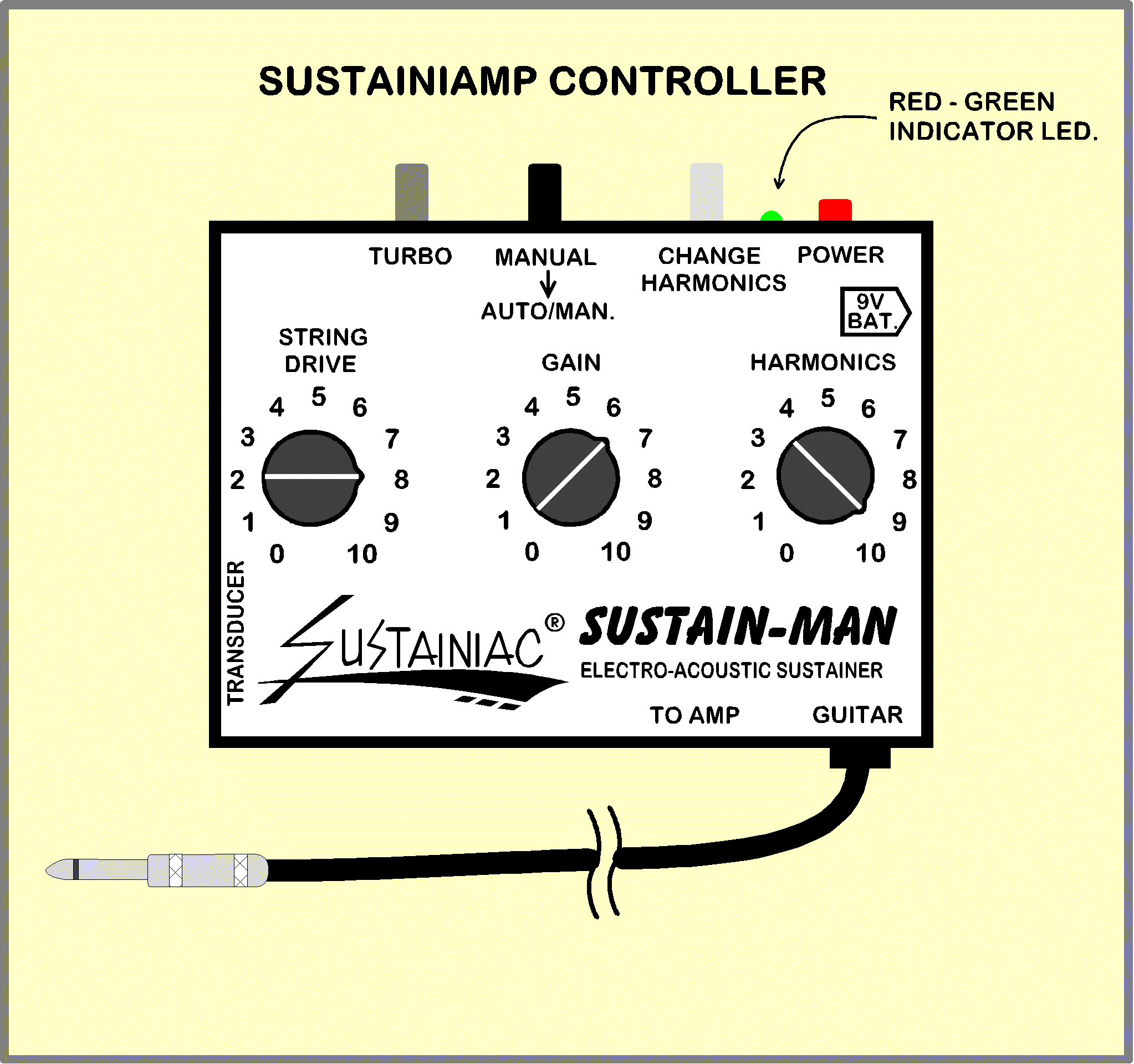
Switches: Dual Mode Harmonic Select control
The Sustainiamp controller/amplifier has four hand-actuated switches. The switches control the sustainer ON/OFF function
and also the harmonics of sustained string vibration. Itís simple to use:
The SUSTAIN-MAN has two modes of operation: MANUAL and AUTOMATIC. The MANUAL-AUTO/MAN switch on the control panel allows you to run in either mode. In either mode, you can force the harmonic mode to change from RED to GREEN and vice-versa by pushing the CHANGE HARMONIC switch. A dual-color LED lights up either GREENor RED, to let the user know which harmonic is being played. In AUTO mode, you can force harmonic changes in another way: Simply lightly touch a vibrating string, or quickly reduce fretting pressure for an instant, and you can force the note to change harmonic vibration mode. Also, in AUTO mode, if a note happens to be out of phase with the sustainer vibration that travels up the neck to the fret, AUTO mode will take the quickly decaying note and change modes, turning the note into a robustly vibrating note. TURBO switch: This switch instantly doubles the sustainer DRIVE POWER from 1/2 to 1 watt. Using it continuously will use up the battery twice as fast as "NON-TURBO" setting.
Knob Functions:
HARMONICS: Changes the frequency equalization of the Sustainiac signal path. Rotating this control full clockwise allows all highs to pass, but attenuates the lows. You get mostly harmonics in sustained vibration. Middle rotation allows both highs and lows to pass. You get both harmonics and fundamentals in sustained vibration. Rotating full counterclockwise allows all lows to pass, but attenuates the highs. You get more fundamentals in this position.
GAIN: Determines how fast sustained string vibration builds up. Full gain produces instantaneous sustain. Lower gains take longer to build up sustained vibration and harmonic changes.
STRING DRIVE: This control controls the amount of string drive power from the sustainer amplifier. Like the GAIN control, it also determines how fast sustained vibration builds up. If you turn it up high, the battery gets used up faster. It also overlaps the above-mentioned GAIN control, but GAIN doesn't affect final string vibration drive power.
DIFFERENCE BETWEEN DRIVE AND GAIN: People often ask what the difference is between these two functions. First, they are both similar in that they both change the overall system gain. This determines how fast the sustained vibrations build up. The important difference is this: The DRIVE function also controls how much energy is actually delivered to the strings. As you hold a sustained note and adjust the DRIVE knob up and down, you can see the string vibration amplitude change. If you have a current meter, you will also see this change in response to DRIVE knob settings. With changes in GAIN setting, you will not see the amplitude change. One way to think of it is to compare these two settings to the PRE-GAIN and POST-GAIN settings of a typical distortion box. The PRE-GAIN setting controls the amount of distortion that the signal has. The POST-GAIN setting controls the volume of the signal. But both settings control the overall amount of system gain.
Transducer mounting details
Why mount the transducer to the headstock? Because the headstock is by far the best place on a
typical electric guitar to mount the transducer. Since the mass of the neck is small compared to the body, it vibrates
very easily. The acoustic vibrations efficiently travel into the strings through the frets.
There is another good reason for mounting the transducer on the headstock: The headstock is the furthest location on the instrument from the pickups. The transducer is basically an electromagnetic device, like a loudspeaker. Putting it on the headstock keeps the intense magnetic field that is radiated by the transducer from being sensed by the pickups. This prevents strange sounds and uncontrollable squeals from being sensed by the instrument pickups. You can turn the gain way up, resulting in robust sustain. Put the transducer too close to the pickups, and an uncontrolled oscillation (squeal) occurs as you turn the gain up, before you get enough gain to make the system sustain properly.
The transducer clamp is easily mounted to a typical headstock by adjusting the thumbscrew for firm (but not tight) pressure. A rubber pad holds the transducer firmly to the headstock with only moderate clamping pressure, and is chemically inert to protect the guitar finish.
Sustain of notes with an electro-acoustic sustainer tends to be much like that of natural feedback that you get from a loud amplifier: Most notes change into cool-sounding harmonics within a short time after the note is played. Some notes will remain as fundamental vibration. Then, you can force the note to go into a harmonic by hitting the CHANGE HARMONICS switch. The best part is that you donít have to play at a loud volume to get screaming feedback sustain! The sensation of playing with the Sustainiac sustainer is very intense and exciting. Musicians often say that it feels like the instrument is actually alive in their hands. This sensation is like playing very, very loudly, yet the instrument amplifier volume can be turned all the way down to zero.
Guitars with piezo and other bridge types
We have also had some success on acoustic guitars having piezo and other bridge types. With piezos, you should have
a built-in preamp to boost the piezo signal, and also to lower its output impedance. One particularly good transducer for this
is the Schertler Bluestick undersaddle transducer. The Bluestick is designed to be an acoustic guitar pickup.
This is actually a small condenser microphone that is
contained inside a small under-saddle tube. Schertlerusa.com
With the Bluestick, you can actually mount the transducer directly on the bridge, because it doesn't respond at all to the
magnetic field that radiates from the SUSTAIN-MAN transducer. What is interesting is that you get
good fundamentals with this, because there is no time delay between the transducer output and the string ends. We have
not done any long break-in experiments with the Bluestick, to determine whether or not this will damage the transducer. If
you are brave and have cash to experiment, this might make a lot of acoustic players happy.
Wireless SUSTAIN-MAN?
People used to often ask if they can use an electro-acoustic sustainer like the Model C (or Model B) and play wireless, without the cord hanging
down. The problem with wireless was that you have to have a lot of power to run an electroacoustic type sustainer like the Model C.
You would have to put BIG batteries inside the guitar body. You would also have to put the Model C Sustainiamp electronics
somewhere inside the body, because it must drive the transducer. You can see from this explanation that it would be very
impractical to do this. But theoretically it is possible.
However now with the SUSTAIN-MAN, it is here.
Pricing
The SUSTAINIAC SUSTAIN-MAN sustainer price is $229.00 (U.S. dollars).
Go to the EMAIL ORDER FORM
Warranty: One year from date of purchase.
Specifications:
Power consumption: 1/2 watt (1 watt in TURBO mode), 9-volt battery.
Sustainiamp input impedance: 1Meg ohm;
Sustainiamp box weight: 9 oz.
Sustainiamp box dimensions: 5"Lx2.5"Wx1"H
Transducer impedance: 16 ohms;
Transducer weight 8 oz. (including cord)
Battery life: 10 hours for one very, very, very long, sustained note. 5 hours in TURBO mode.
Shipping weight: 1.5 LB. Amplifier dimensions: 5" L x 2.5" W x 1" H.
How the Sustainiac Sustain-Man sustainer works
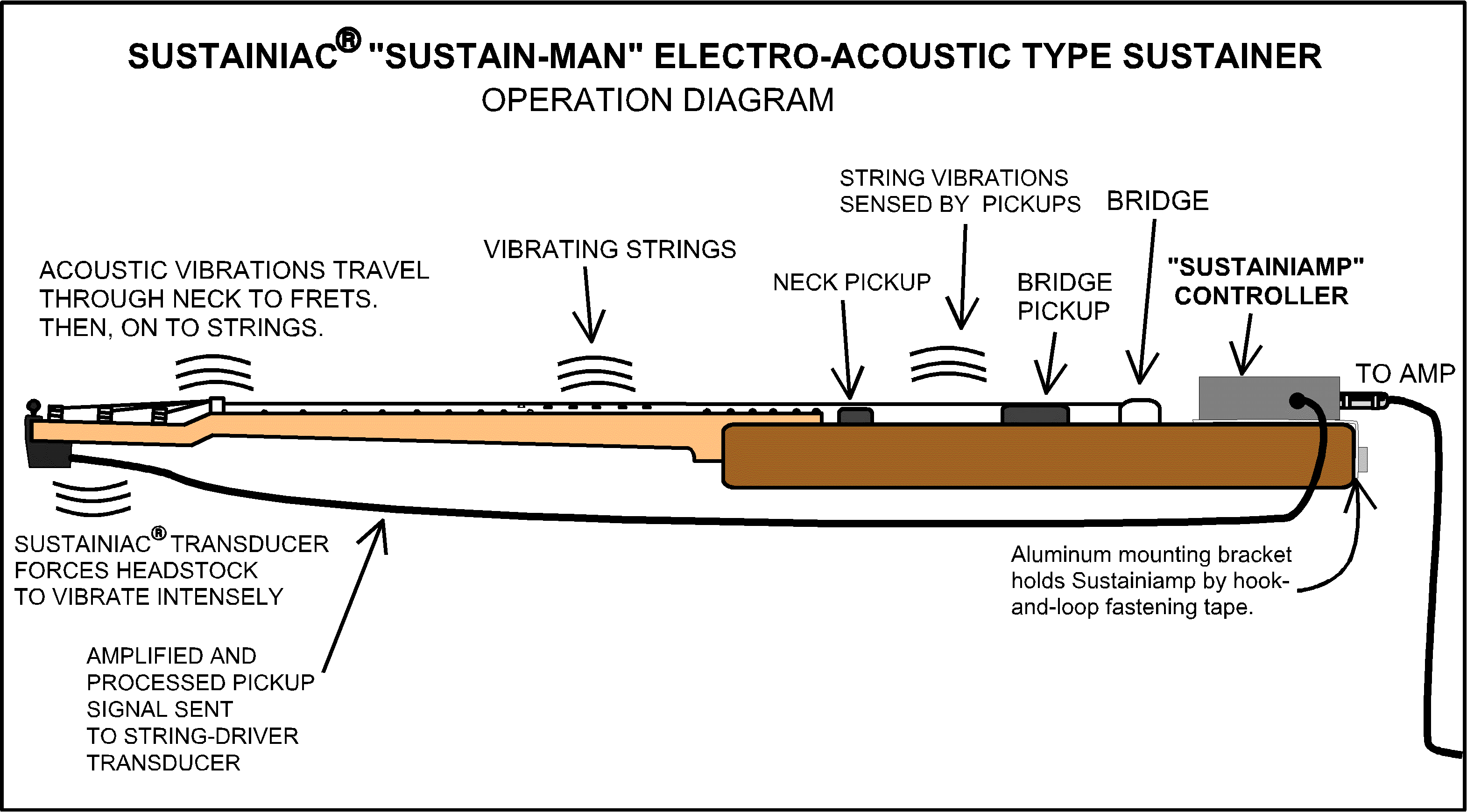
Your instrument pickup signal is sent to the GUITAR input on the Sustainiamp floorbox. The GUITAR wire is
hardwired to the OUTPUT jack, so the instrument pickup signal can be sent to your amp or other effects without alteration.
The pickup signal is processed and amplified by the electronic circuitry inside the Sustainiamp. This processed
and amplified pickup signal is then passed on to the transducer through the TRANSDUCER jack. The transducer converts
the amplified, processed guitar pickup signal into intense acoustic vibrations. The Sustainiac SUSTAIN MAN transducer is
actually a specialized loudspeaker which is designed to transmit acoustic energy into MASS, not air like a conventional
loudspeaker. Like your amp loudspeaker, these acoustic vibrations are in synchronization with the string vibrations.
The vibrations are directly sent into the instrument. They travel to the instrument strings. Since the acoustic vibrations
are in synchronization with the string vibrations, they add acoustic energy to the strings during each and every vibration.
This is what sustains the vibrations, because the vibrations never lose energy unless the power is removed. (It is much
like pushing on a swing. You add a little energy each time the swing passes by, and it sustains its vibration provided you
give the push at the right time, and you donít stop pushing.)
5348 N. Tacoma Avenue, Indianapolis IN 46220 Phone: 317-340-1161
email: info@sustainiac.com